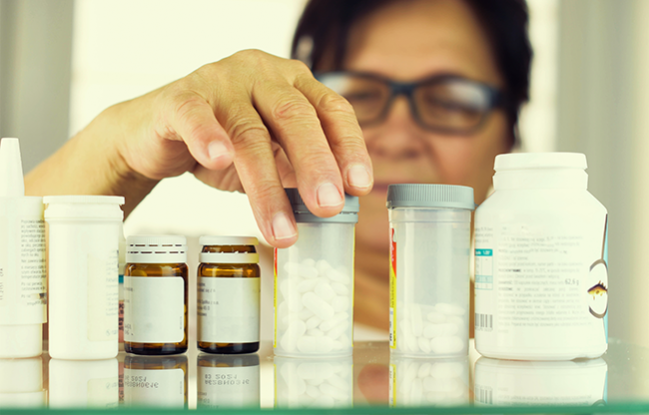Avoid Simvastatin, Lovastatin in Dabigatran-Treated Patients, Analysis Suggests

Patients with nonvalvular A-fib taking dabigatran for stroke prevention may want to avoid starting simvastatin or lovastatin to lower their lipids, a new analysis suggests.
Use of those statins instead of other drugs in the class was associated with a higher risk of major hemorrhage, with no effect on ischemic stroke/TIA rates, lead author Tony Antoniou, PhD (St. Michael’s Hospital, Toronto, Canada), and colleagues report in a study published online November 21, 2016, ahead of print in the Canadian Medical Association Journal.
Antoniou told TCTMD that the findings might have a clinical impact. “We know that for patients who have heart disease, statins are important drugs. And so, for patients who are receiving dabigatran etexilate, there’s no reason to deny them statins,” he said. But, he added, clinicians could preferentially administer “other statins that would still give you the same benefit of this class of drugs for patients with heart disease without giving you the potential for an excess risk of a bleed.”
Commenting on the study for TCTMD, John Horn, PharmD (University of Washington Medical Center, Seattle), said that that is a reasonable conclusion to draw from the results, noting that there is a plausible biological mechanism to explain the interaction.
Dabigatran etexilate (Pradaxa; Boehringer Ingelheim) is a prodrug that requires absorption in the gut followed by conversion to its active form. Absorption in the intestine is influenced by P-glycoprotein, whose action is inhibited by simvastatin and lovastatin, but not other statins. Impeding the function of P-glycoprotein results in an increase in the absorption of dabigatran etexilate, and in turn, higher plasma concentrations of the active drug after conversion by carboxylesterase, potentially increasing the risk of bleeding.
He noted that prior research has shown that other medications that inhibit P-glycoprotein—of which there are many—can cause increases of up to 200% in plasma concentrations of dabigatran.
“From the clinician’s standpoint, you just want to be careful that if you’re going to use [dabigatran], you want to try and avoid using it in patients who are getting drugs that interfere with P-glycoprotein activity,” Horn said.
“Even though the absolute risk of bleeding here is pretty low, it’s something that you really don’t want to have happen,” he added. “So we would try to avoid that and that means avoiding the use of either simvastatin or lovastatin with dabigatran, and if you have to use one of those two drugs . . . then I would probably suggest using a different anticoagulant.”
Unsurprising Findings
To assess the possibility that coadministration of those statins with dabigatran worsens clinical outcomes, the investigators conducted two nested case-control studies using Ontario’s administrative health databases, one evaluating ischemic stroke/TIA risk and the other major hemorrhage risk. The analyses drew from 45,991 patients ages 66 and older who started taking dabigatran between May 2012 and March 2014. Each case was matched with up to four controls, all of whom were on a single statin in the 60 days leading up to the index date.
After multivariate adjustment, using simvastatin or lovastatin versus other statins was not associated with the risk of ischemic stroke/TIA (adjusted OR 1.33; 95% CI 0.88-2.01), but was related to a higher risk of major hemorrhage (adjusted OR 1.46; 95% CI 1.17-1.82).
Although the lack of a link between use of the statins and stroke risk could reflect insufficient statistical power, Antoniou said the findings aren’t surprising when looking at the underlying pharmacology. Simvastatin and lovastatin will be present in high enough concentrations to block P-glycoprotein and increase absorption of dabigatran etexilate, but the concentrations of the statins might be too low to inhibit the process of converting the prodrug into the active form (which would be expected to reduce the effectiveness of dabigatran), he said.
Horn agreed that the findings were not unexpected based on the actions of the drugs: “I think what they saw is exactly what you would predict would happen from this particular interaction.”
What About Other NOACs?
When asked whether a similar interaction might be seen with other non-vitamin K antagonist oral anticoagulants (NOACs), Horn said that it is a possibility because those other agents are also influenced by P-glycoprotein activity.
He said dabigatran is particularly susceptible, however, because its bioavailability is low compared with the other NOACs (about 6% as opposed to 50% to 80%). Any interaction that influences the amount of drug that enters the bloodstream will thus have a much larger relative impact on dabigatran.
“It’s completely plausible to me that you could get enough of an increase in bioavailability with an inhibitor of [P-glycoprotein] to increase the plasma concentrations of dabigatran enough to increase the risk of bleeding,” Horn said. “And I think that’s exactly what these researchers found.”
Todd Neale is the Associate News Editor for TCTMD and a Senior Medical Journalist. He got his start in journalism at …
Read Full BioSources
Antoniou T, Macdonald EM, Yao Z, et al. Association between statin use and ischemic stroke or major hemorrhage in patients taking dabigatran for atrial fibrillation. CMAJ. 2016;Epub ahead of print.
Disclosures
- This project was supported by research funds from the Canadian Drug Safety and Effectiveness Research Network and by the Institute for Clinical Evaluative Sciences (ICES), which is funded by a grant from the Ontario Ministry of Health and Long-Term Care. The Canadian Drug Safety and Effectiveness Research Network is funded by an Emerging Team Grant from the Canadian Institutes of Health Research (CIHR).
- Antoniou reports being supported by a New Investigator Salary Award from CIHR.
- Horn reports no relevant conflicts of interest.


Comments